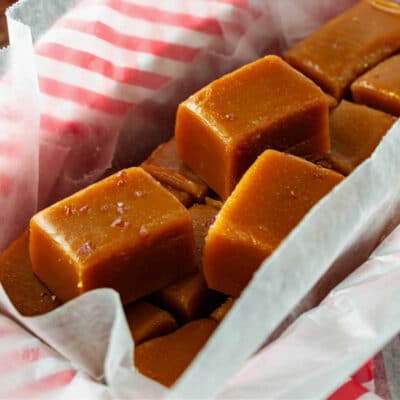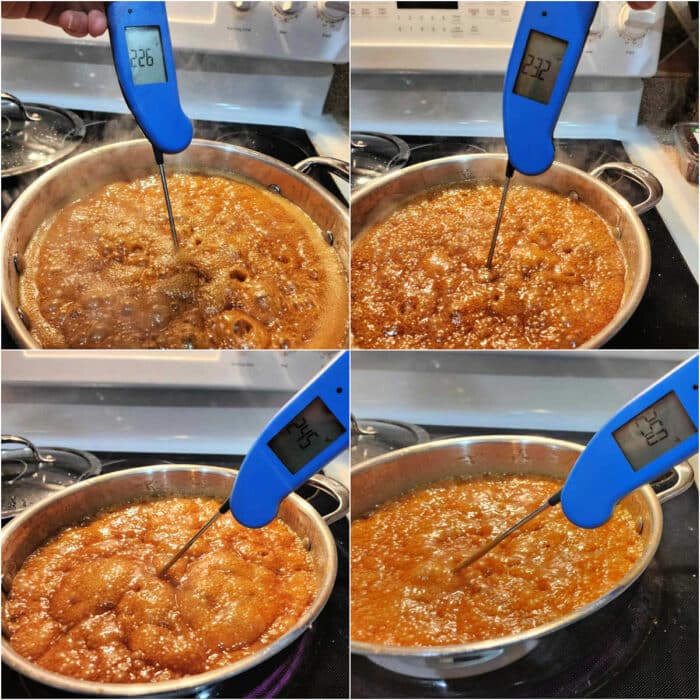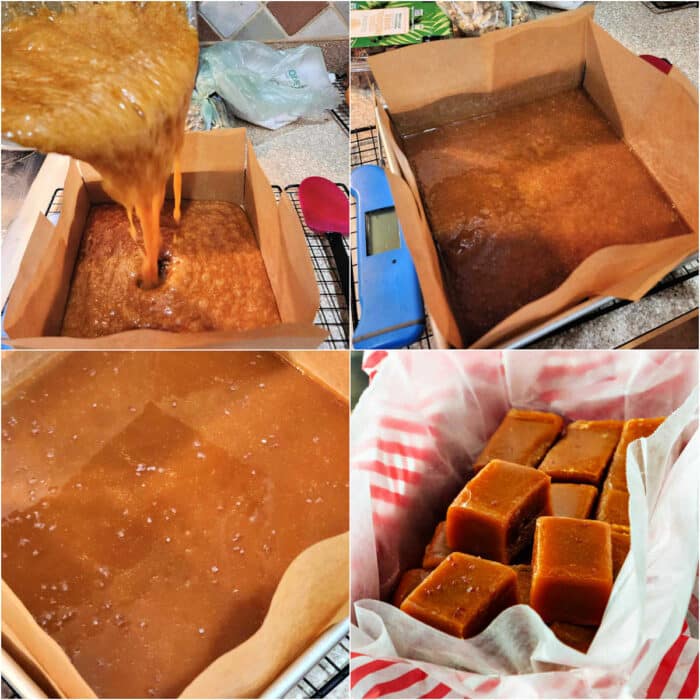
Butterscotch Candy
Back in the mid-ish 1800s, a British confectioner went and visited Italy and apparently was both saddened to find that their sweets were better than what was available in England and inspired to Fix That. Butterscotch is what he came up with. Good show, old man. This recipe makes a relatively soft candy that should be stored in the refrigerator. See the notes for the temperatures to cook it to get everything from a sauce to a much firmer candy.NOTE: All measurements are By Weight, not volume, even the liquids. Please use a kitchen scale to make this candy.
Servings 64 pieces
Calories 83kcal
Equipment
Ingredients
- 1 pound unsalted butter 4 sticks or 450 grams
- 10-14 grams fine sea salt or to taste (about 2-2 1/2 teaspoons)
- 4 oz water 1/2 cup or 113 grams
- 4 oz molasses, by weight and NOT by volume 112 grams, by weight. By volume: 1/4 cup plus 1 Tablespoon plus 2 teaspoons
- 1 pound granulated sugar 450 grams or about 2 1/4 cups
Instructions
- Cut a strip of non-stick foil or parchment to the same width as the bottom of an 8" or 9" baking dish. Line the pan, making sure the edges of the foil extend up and over opposite sides of the pan. Don't worry about the unlined sides.
- Spray the whole shebang very well with pan spray, especially the unlined sides. Set aside on a heat-proof surface. You can also choose to line the pan "both ways," covering all 4 sides like you can see in the photos. In that case, you won't need to use any pan spray.
- In a medium saucepan, melt the butter, along with the salt, over medium-low heat.
- Once the butter is about half melted, add the molasses and water, and continue heating, stirring occasionally, until the butter has completely melted but the mixture hasn't come to a boil yet.
- When the mixture is good and liquidy, add the sugar, increase the heat to medium to medium-high, and bring to a boil, stirring constantly until all the sugar has dissolved (it doesn't feel at all grainy when you rub a little between your fingers).

- Once the mixture comes to a good, rolling boil, cook the candy to 250F and then pour into your prepared pan. NOTE: You're not really supposed to stir during this part, but sometimes it's hard to stop yourself. If you do decide to stir, stir carefully with a clean, silicone spatula, and rinse it off between stirs.

- Let sit out until cool, and then score the candy into 1" squares for later cutting. Run a thin spatula between the unlined sides of the pan and the butterscotch, and and let it sit out, loosely covered with a lint-free towel, for about 24 hours in a cool kitchen.
- Remove to a cutting board, and cut into whatever shapes you want. This will make about 48-64 pieces of butterscotch, depending on how you cut them. NOTE: Because of all the butter in the candy, it will soften quickly at room temperature, so cut it and then store it in the fridge. A bit of butter may leak out when slicing, but most will get reabsorbed into the candy. See NOTES below for other target temperatures to make candies of different textures.

Notes
To make authentic butterscotch sauce, cook the ingredients to 240F.
To make a firmer candy that will hold its shape at room temperature, cook the ingredients to 260-280F, realizing that the higher the temperature, the firmer it will set up when it cools.
If you cook the ingredients to 305-310F, you've just made toffee, so pour it onto a Silpat-lined baking sheet covered with Toasted Nuts of choice, although almond is traditional.
Always let your candy sit undisturbed (except for scoring) for a good 24 hours to allow it to crystallize properly.
Nutritional information is calculated for 64 pieces of candy.
Nutrition
Calories: 83kcal | Carbohydrates: 8g | Saturated Fat: 3g | Cholesterol: 15mg | Sodium: 62mg | Sugar: 8g